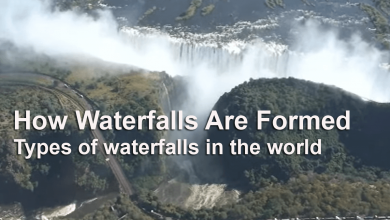
Mountains are some of the most beautiful and impressive landforms on Earth. They are characterized by steep slopes, towering peaks, and awe-inspiring vistas. But what causes mountains to form?
In this article, we will explore how hills and mountains are formed, including the role of plate tectonics, convergent boundaries, erosion, and other factors. We will also take a closer look at the different types of mountains and where they are found around the world.
Read Also: Mountain Habitat Animals and Plants Examples
How Hills and Mountains Are Formed
There are three primary types of mountains: volcanic, fold, and fault-block. Each type forms in a different way and has distinct characteristics.
Types of Mountains and How They Are Formed
There are several different types of mountains, including volcanic, fold, fault-block, and dome mountains.
Volcanic Mountains
Volcanic mountains are formed when magma and lava erupt from a volcano and harden into rock. As the molten rock cools and hardens, it builds up into a cone-shaped peak. Over time, repeated eruptions can cause the mountain to grow higher and higher. Examples of volcanic mountains include Mount Fuji in Japan and Mount Kilimanjaro in Africa.
Fold Mountains
Fold mountains are formed by the compression of rock layers caused by tectonic plate movement. The layers of rock are squeezed and folded, forming long, linear mountain ranges. The Appalachian Mountains in North America and the Himalayas in Asia are examples of fold mountains.
Fault-block Mountains
Fault-block mountains are created when tectonic forces cause large blocks of the earth’s crust to uplift or downshift along a fault line. The result is a steep mountain range with one side that rises sharply and another that slopes more gently. The Sierra Nevada in California and the Rocky Mountains in North America are examples of fault-block mountains.
How Are Mountains Formed by Plate Tectonics
The primary cause of mountain formation is the movement of tectonic plates. When two or more plates collide, the landmasses can be pushed up or folded, creating mountain ranges. This process is known as orogeny. When two plates collide head-on, the landmasses can be forced upward, forming large, high mountains.
This is how the Himalayas, the Andes, and the Rockies were formed. At a convergent boundary, where one plate slides beneath another, the plates can also buckle and form mountains.
Examples of this type of mountain formation include the Japanese Alps and the Cascades in North America.
How Are Mountains Formed by Erosion
Erosion can also play a role in mountain formation. Over time, wind, water, and other natural forces can wear away at the mountains, shaping them into new formations.
In some cases, erosion can cause the mountain to become shorter or less steep. In other cases, erosion can create new mountain ranges entirely.
The Himalayas, for example, were formed in part by the erosion of ancient mountains that existed millions of years ago.
Where Are Mountains Found?

Mountains are found on every continent on Earth, from the Andes in South America to the Alps in Europe to the Himalayas in Asia. Some of the most famous mountain ranges include the Rocky Mountains in North America, the Andes in South America, the Alps in Europe, and the Himalayas in Asia.
Block Mountains
Finally, let’s take a closer look at block mountains. These are mountains that are formed when large blocks of rock are uplifted and tilted along a fault line. This can create a steep-sided mountain with one side that rises sharply and another that slopes more gently. The Vosges Mountains in France and the Harz Mountains in Germany are examples of block mountains.
- What is a Beach? How Are Beaches Formed?
- List of Landforms A to Z on Earth
- Which Land Feature Supports the Theory of Continental Drift?
- How are Sedimentary Rocks Formed: Understanding the Formation Process
- Why is a Delta Often Used as an Agricultural Area?
However, mountains are some of the most awe-inspiring landforms on Earth. They are formed through the complex interplay of tectonic plate movement, erosion, and other natural forces. From the towering peaks of the Himalayas to the rolling hills of the Appalachians, mountains are found all over the world and come in a variety of shapes and sizes. Whether you are a hiker, a climber, or simply an admirer of natural beauty.




